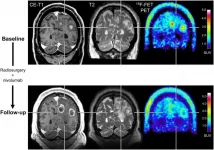INFORMATION:
About Mayo Clinic
Mayo Clinic is a nonprofit organization committed to innovation in clinical practice, education and research, and providing compassion, expertise and answers to everyone who needs healing. Visit the Mayo Clinic News Network for additional Mayo Clinic news. For information on COVID-19, including Mayo Clinic's Coronavirus Map tracking tool, which has 14-day forecasting on COVID-19 trends, visit the Mayo Clinic COVID-19 Resource Center.
HEPA filter effectively reduces airborne respiratory particles generated during vigorous exercise
2021-05-04
(Press-News.org) ROCHESTER, Minn. -- A pair of Mayo Clinic studies shed light on something that is typically difficult to see with the eye: respiratory aerosols. Such aerosol particles of varying sizes are a common component of breath, and they are a typical mode of transmission for respiratory viruses like COVID-19 to spread to other people and surfaces.
Researchers who conduct exercise stress tests for heart patients at Mayo Clinic found that exercising at increasing levels of exertion increased the aerosol concentration in the surrounding room. Then also found that a high-efficiency particulate air (HEPA) device effectively filtered out the aerosols and decreased the time needed to clear the air between patients.
"Our work was conducted with the support of Mayo Cardiovascular Medicine leadership who recognized right at the start of the pandemic that special measures would be required to protect patients and staff from COVID-19 while continuing to provide quality cardiovascular care to all who needed it," says Thomas Allison, Ph.D., director of Cardiopulmonary Exercise Testing at Mayo Clinic in Rochester. "Since there was no reliable guidance on how to do this, we put a research team together to find answers through scientific testing and data. We are happy to now share our findings with everyone around the world." Dr. Allison is senior author of both studies.
To characterize the aerosols generated during various intensities of exercise in the first study, Dr. Allison's team set up a special aerosol laboratory in a plastic tent with controlled airflow. Two types of laser beam particle counters were used to measure aerosol concentration at the front, back and sides of a person riding an exercise bike. Eight exercise volunteers wore equipment to measure their oxygen consumption, ventilation and heart rate.
During testing, a volunteer first had five minutes of resting breathing, followed by four bouts of three-minute exercise staged ? with monitoring and coaching ? to work at 25%, 50%, 75% and 100% of their age-predicted heart rate. This effort was followed by three minutes of cooldown. The findings are publicized online in CHEST.
The aerosol concentrations increased exponentially throughout the test. Specifically, exercise at or above 50% of resting heart rate showed significant increases in aerosol concentration.
"In a real sense, I think we have proven dramatically what many suspected ? that is why gyms were shut down and most exercise testing laboratories closed their practices. Exercise testing was not listed as an aerosol-generating procedure prior to our studies because no one had specifically studied it before. Exercise generates millions of respiratory aerosols during a test, many of a size reported to have virus-carrying potential. The higher the exercise intensity, the more aerosols are produced," says Dr. Allison.
The follow-up study led by Dr. Allison focused on how to mitigate the aerosols generated during exercise testing by filtering them out of the air immediately after they came out of the subject's mouth. Researchers used a similar setup with the controlled airflow exercise tent, particle counter and stationary bike, but added a portable HEPA filter with a flume hood.
Six healthy volunteers completed the same 20-minute exercise test as the previous study, first without the mitigation and then with the portable HEPA filter running.
Also, a separate experiment tested aerosol clearance time in the clinical exercise testing laboratories by using artificially generated aerosols to test how long it took for 99.9% of aerosols to be removed. Researchers performed the test first with only existing heating, ventilation and air conditioning, and then with the addition of the portable HEPA filter running.
"Studying clearance time informed us of how soon we could safely bring a new patient into the laboratory after finishing the test on the previous patient. HEPA filters cut this time by 50%, allowing the higher volume of testing necessary to meet the clinical demands of our Cardiovascular Medicine practice," says Dr. Allison.
"We translated CDC (Centers for Disease Control and Prevention) guidelines for aerosol mitigation with enhanced airflow through HEPA filters and showed that it worked amazingly well for exercise testing. We found that 96% plus or minus 2% of aerosols of all sizes generated during heavy exercise were removed from the air by the HEPA filter. As a result, we have been able to return to our practice of performing up to 100 stress tests per day without any recorded transmission of COVID in our exercise testing laboratories," says Dr. Allison.
ELSE PRESS RELEASES FROM THIS DATE:
With new treatments, PET imaging adds valuable information to brain metastasis monitoring
2021-05-04
Reston, VA--For patients with brain metastases, amino acid positron emission tomography (PET) can provide valuable information about the effectiveness of state-of-the-art treatments. When treatment monitoring with contrast-enhanced magnetic resonance imaging (MRI) is unclear, adding 18F-FET PET can help to accurately diagnose recurring brain metastases and reliably assess patient response. This research was published in The Journal of Nuclear Medicine.
Newer treatment options for patients with brain metastases--such as immune checkpoint inhibitors and targeted therapies--are effective, but can cause a variety of side effects. ...
Immunomics: A conversation on the future of diagnostics with Ramy Arnaout
2021-05-04
The human immune system doesn't just protect our health, it reflects it. Each encounter with a potential disease-causing agent causes the body to produce specific immune agents -- proteins known as antibodies and T-cell receptors -- tailor-made to recognize and destroy the invader. Tasked with preventing re-infection, antibodies and T-cell receptors (TCR) from your previous encounters circulate throughout the body indefinitely, like a record of your personal medical history that you carry inside of you.
Clinical pathologist Ramy Arnaout, MD, DPhil, ...
Emergency physicians first to safely treat vaccine-induced blood clot with heparin alternative
2021-05-04
WASHINGTON, DC -- A new case report, detailed in Annals of Emergency Medicine, is the first known case of a patient with VITT (vaccine-induced thrombotic thrombocytopenia) treated with a heparin alternative following the Centers for Disease Control and Prevention (CDC) guidance.
An otherwise healthy female patient in her 40s came to the emergency department at UCHealth University of Colorado Hospital twelve days after receiving the Johnson & Johnson vaccine with a headache, dizziness, and vision changes. The patient was treated on April 13, 2021, the same day that the Centers for Disease Control and Prevention (CDC) announced a pause in the administration of the Johnson & Johnson vaccine. CDC guidance recommended ...
The sensitive brain at rest
2021-05-04
You know that raw overwhelm people have been reporting after months of a pandemic, compounded by economic issues and social unrest? Does fatigue and compulsive social media scrolling strike a familiar chord?
Those brittle feelings offer us a glimpse into what regular life can be like for individuals with sensory processing sensitivity (SPS), a biological trait possessed by roughly a third of the population. In a world of constant information overload and stress, it's a characteristic that can result in a variety of behaviors, from emotional outbursts to withdrawal, overwhelm and procrastination.
"Behaviorally, we observe it as being more careful and cautious when approaching new things," said Bianca Acevedo, a researcher ...
New GSA Bulletin articles published ahead of print in April
2021-05-04
Boulder, Colo., USA: The Geological Society of America regularly publishes
articles online ahead of print. For April, GSA Bulletin topics
include multiple articles about the dynamics of China and Tibet; the Bell
River hypothesis that proposes that an ancestral, transcontinental river
occupied much of northern North America during the Cenozoic Era; new
findings in the climatic history during one of the Earth's coldest periods:
The Late Paleozoic Ice Age; and the age an nature of the Chicxulub impact
crater. You can find these articles at END ...
A calculator that predicts risk of lung cancer underperforms in diverse populations
2021-05-04
PHILADELPHIA - Lung cancer is the third most common cancer in the U.S. and the leading cause of cancer death, with about 80% of the total 154,000 deaths recorded each year caused by cigarette smoking. Black men are more likely to develop and die from lung cancer than persons of any other racial or ethnic group, pointing to severe racial disparities. For example, research has shown that Black patients are less likely to receive early diagnosis and life-saving treatments like surgery. Now researchers at Jefferson have found that a commonly used risk prediction model does not accurately identify high-risk Black patients who could gain life-saving benefit from early screening, and paves the way for improving screenings and guidelines. The research was published in JAMA Network ...
Investigating the role of Brd4 in diet-induced obesity
2021-05-04
A new study, published in JCI Insight, looks at how Brd4, a regulator of the innate immune response, influences diet-induced obesity. The researchers believe that Brd4 could be used as a target for obesity and insulin resistance.
Approximately one-third of the adults and one in five children in the U.S. have obesity problems. Unfortunately, the condition is also associated with the development of other diseases including diabetes, cardiovascular disorders, and cancer. "One of the biggest challenges we face is trying to understand how people develop obesity. If we can understand that, we can develop solutions for treating or preventing these diseases," said Lin-Feng Chen (MME), a professor of biochemistry.
The researchers investigated the role of the ...
Soybean cyst nematode is the most damaging soybean pathogen--and it's rapidly spreading
2021-05-04
The soybean cyst nematode (SCN) is the most damaging pathogen of soybean in the United States and Canada and it is spreading rapidly, according to information compiled by Gregory Tylka and Christopher Marett, nematologists at Iowa State University. SCN was first found in the United States in 1954 and most recent estimates show that SCN results in $1.5 billion in annual yield losses.
"The continuing spread of SCN is alarming, but not surprising," said Tylka. "Anything that moves soil can move the nematode, including wind, water, and farm machinery." ...
More youth report concussions since 2016, U-M study shows
2021-05-04
Educating athletes, parents and coaches about concussion treatment and prevention has been a priority during the last decade, but are the intended audiences hearing the message?
New research from the University of Michigan found that 1 in 4 adolescents self-reported at least one concussion in 2020, up from about 20% in 2016. During that same time period, youth who reported one concussion rose from roughly 14% to 18%, and those who reported at least two concussions increased from about 6% to 7%.
"Self-reported concussions could be increasing given that both children and parents have greater ...
New graphite-based sensor technology for wearable medical devices
2021-05-04
Researchers at AMBER, the SFI Centre for Advanced Materials and BioEngineering Research, and from Trinity's School of Physics, have developed next-generation, graphene-based sensing technology using their innovative G-Putty material.
The team's printed sensors are 50 times more sensitive than the industry standard and outperform other comparable nano-enabled sensors in an important metric seen as a game-changer in the industry: flexibility.
Maximising sensitivity and flexibility without reducing performance makes the teams' technology an ideal candidate for the emerging areas ...


